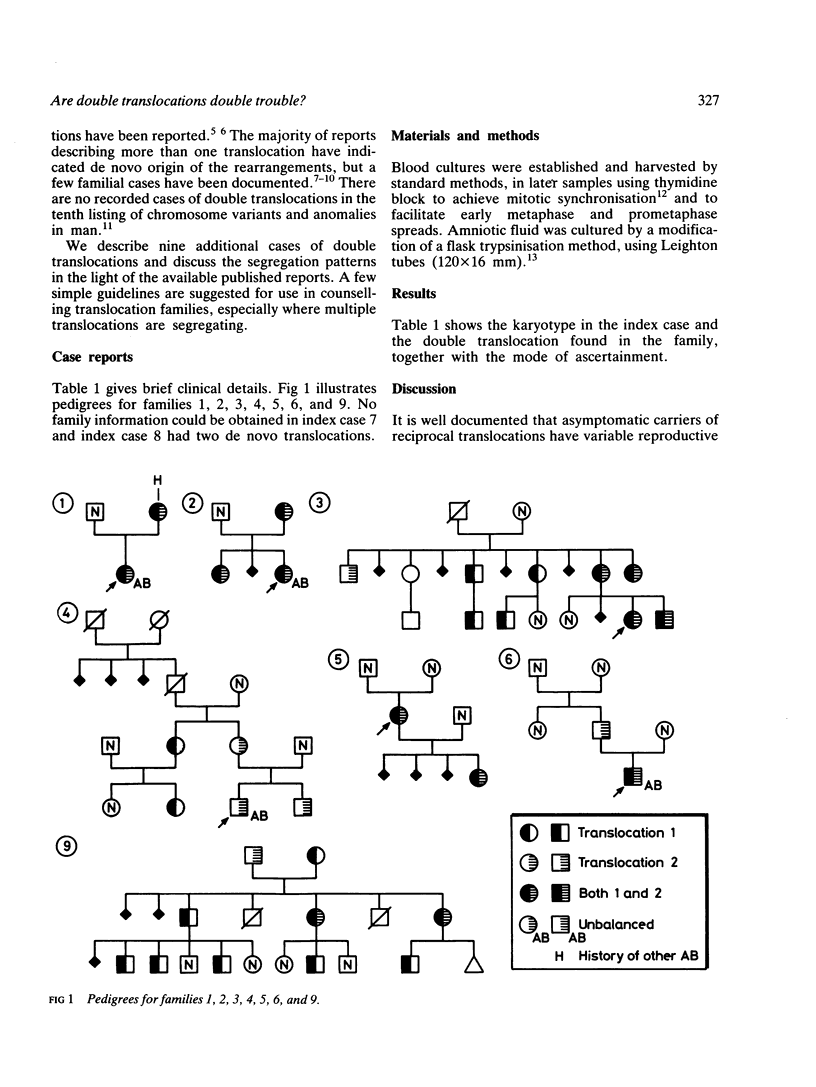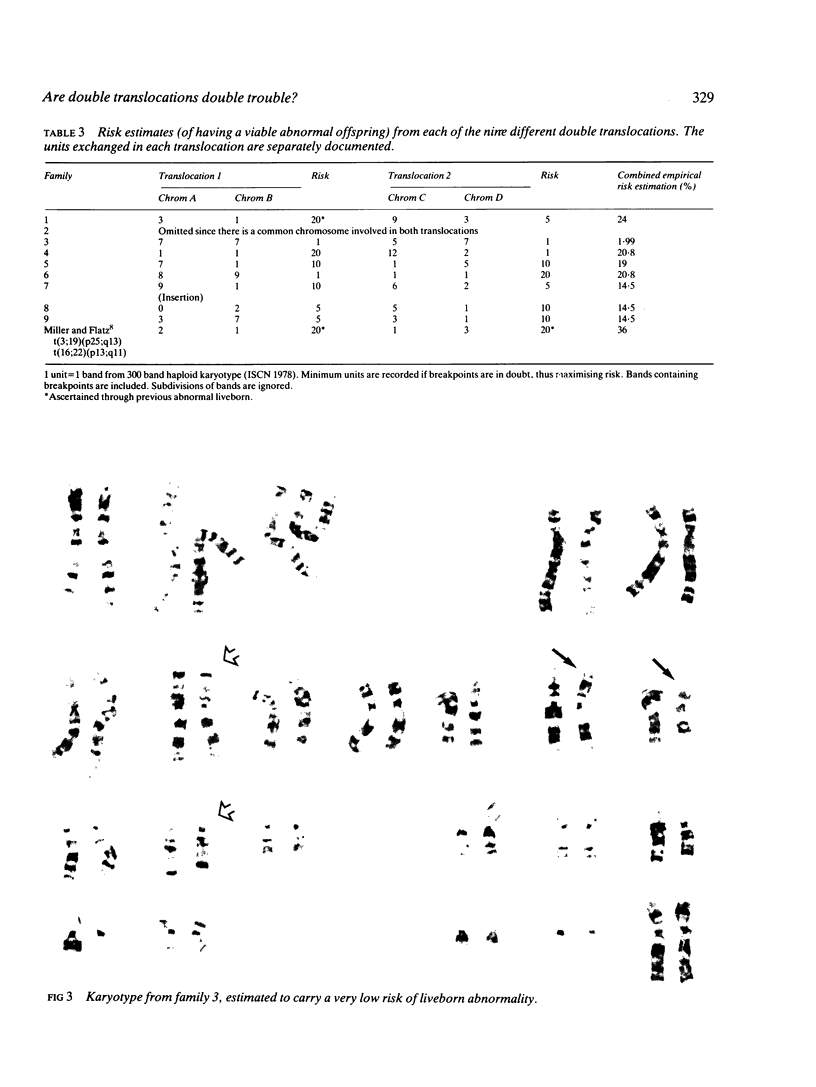Abstract
Double translocation heterozygotes are rare, but need not necessarily pose more of a counselling problem than single reciprocal translocation heterozygotes. Nine cases of double translocation are presented, together with a review of the few reports published to date. An attempt is made to provide simple counselling guidelines in the assessment of the risk of producing a liveborn abnormal child. This is not based on theoretical considerations of segregation patterns, but extrapolated from what is known empirically about the viable segregation patterns in carriers of single reciprocal translocations. It assumes that there is no interference with the independent assortment of the two separate exchanges, unless a common participating chromosome is involved. The possibility of an interchromosomal effect has not been taken into consideration.
Full text
PDF





Images in this article
Selected References
These references are in PubMed. This may not be the complete list of references from this article.
- Aurias A., Prieur M., Dutrillaux B., Lejeune J. Systematic analysis of 95 reciprocal translocations of autosomes. Hum Genet. 1978 Dec 29;45(3):259–282. doi: 10.1007/BF00278725. [DOI] [PubMed] [Google Scholar]
- Bass H. N., Sparkes R. S., Lessner M. M., Fox M., Phoenix B., Bernar J. A family with three independent autosomal translocations associated with 7q32----7qter syndrome. J Med Genet. 1985 Feb;22(1):59–63. doi: 10.1136/jmg.22.1.59. [DOI] [PMC free article] [PubMed] [Google Scholar]
- Bass H. N., Sparkes R. S. Two balanced translocations in three generations of a pedigree: t(7;10) (q11;q22) and t(14;21) (14qter to cen to 21qter)1. J Med Genet. 1979 Jun;16(3):215–218. doi: 10.1136/jmg.16.3.215. [DOI] [PMC free article] [PubMed] [Google Scholar]
- Bell E. F., Warburton D. Two reciprocal translocations associated with microcephaly and retardation. J Med Genet. 1977 Apr;14(2):141–142. doi: 10.1136/jmg.14.2.141. [DOI] [PMC free article] [PubMed] [Google Scholar]
- Bijlsma J. B., de France H. F., Bleeker-Wagemakers L. M., Dijkstra P. F. Double translocation t(7;12),t(2;6) heterozygosity in one family. A contribution to the trisomy 12p syndrome. Hum Genet. 1978 Jan 19;40(2):135–147. doi: 10.1007/BF00272294. [DOI] [PubMed] [Google Scholar]
- Daniel A. Structural differences in reciprocal translocations. Potential for a model of risk in Rcp. Hum Genet. 1979 Oct 1;51(2):171–182. doi: 10.1007/BF00287173. [DOI] [PubMed] [Google Scholar]
- Davis J. R., Rogers B. B., Hagaman R. M., Thies C. A., Veomett I. C. Balanced reciprocal translocations: risk factors for aneuploid segregant viability. Clin Genet. 1985 Jan;27(1):1–19. doi: 10.1111/j.1399-0004.1985.tb00179.x. [DOI] [PubMed] [Google Scholar]
- De Arce M. A., Grace P. M., McManus S. A computer model for the study of segregation in reciprocal translocation carriers: application to 20 new cases. Am J Med Genet. 1986 Jul;24(3):519–525. doi: 10.1002/ajmg.1320240315. [DOI] [PubMed] [Google Scholar]
- Jacobs P. A., Buckton K. E., Christie S., Newton M., Matthew D. A family with two translocations and a polymorphism involving chromosome 14. J Med Genet. 1974 Mar;11(1):65–68. doi: 10.1136/jmg.11.1.65. [DOI] [PMC free article] [PubMed] [Google Scholar]
- Miller K., Flatz S. D. Segregation of two independent chromosomal translocations in one family. Hum Genet. 1984;68(1):93–95. doi: 10.1007/BF00293881. [DOI] [PubMed] [Google Scholar]
- Mulcahy M. T., Watson M. Prenatal diagnosis of a double heterozygote for two reciprocal translocations of familial origin. Prenat Diagn. 1983 Oct;3(4):351–353. doi: 10.1002/pd.1970030413. [DOI] [PubMed] [Google Scholar]
- Watt J. L., Couzin D. A. De novo translocation heterozygote with three reciprocal translocations. J Med Genet. 1983 Oct;20(5):385–388. doi: 10.1136/jmg.20.5.385. [DOI] [PMC free article] [PubMed] [Google Scholar]
- de Grouchy J., Finaz C., Roubin M., Roy J. Deux translocations familiales survenues ensemble chez chacune de deuc soeurs, l'une équilibrée, l'autre trisomique partielle 10q. Ann Genet. 1972 Jun;15(2):85–92. [PubMed] [Google Scholar]
- de Grouchy J., Lautmann F. Caryotype 46, XX, 1q-, 2q-, Dq+, 16q+ chez une enfant polymalformée. Ann Genet. 1968 Jun;11(2):129–131. [PubMed] [Google Scholar]



